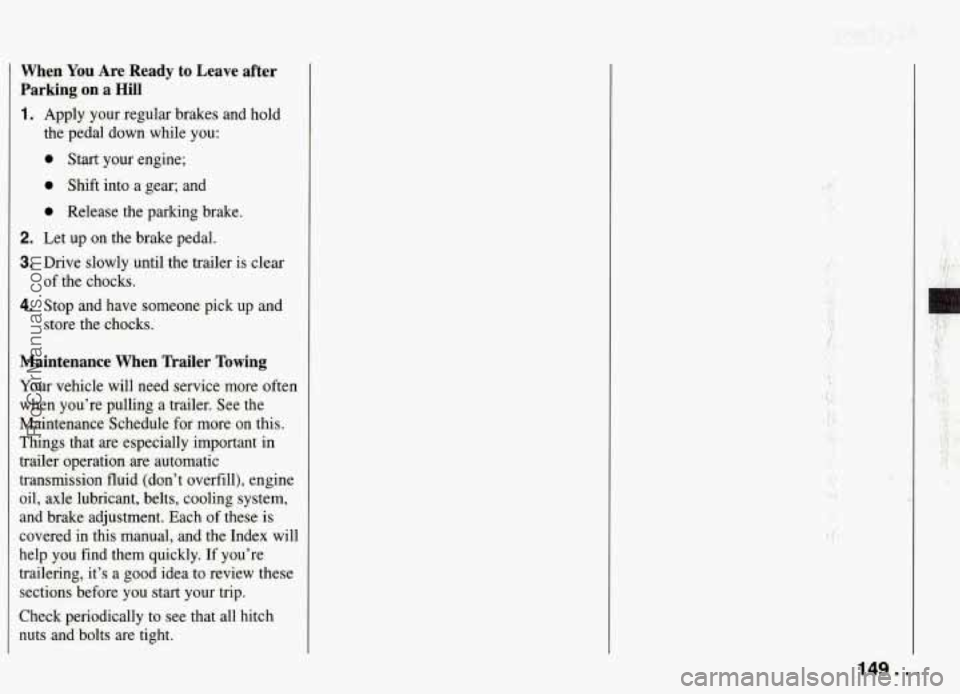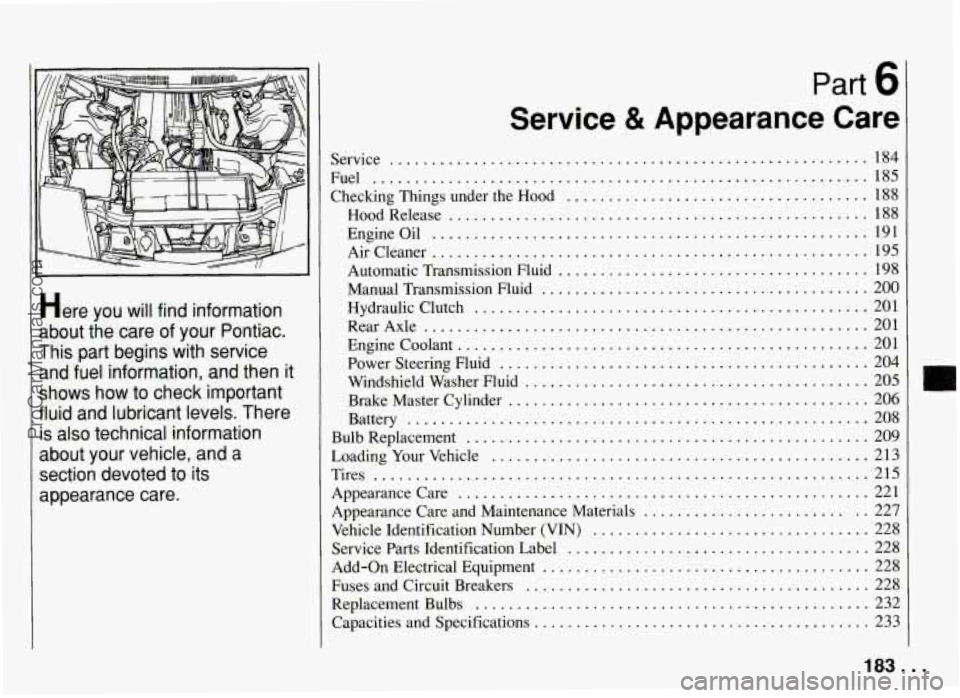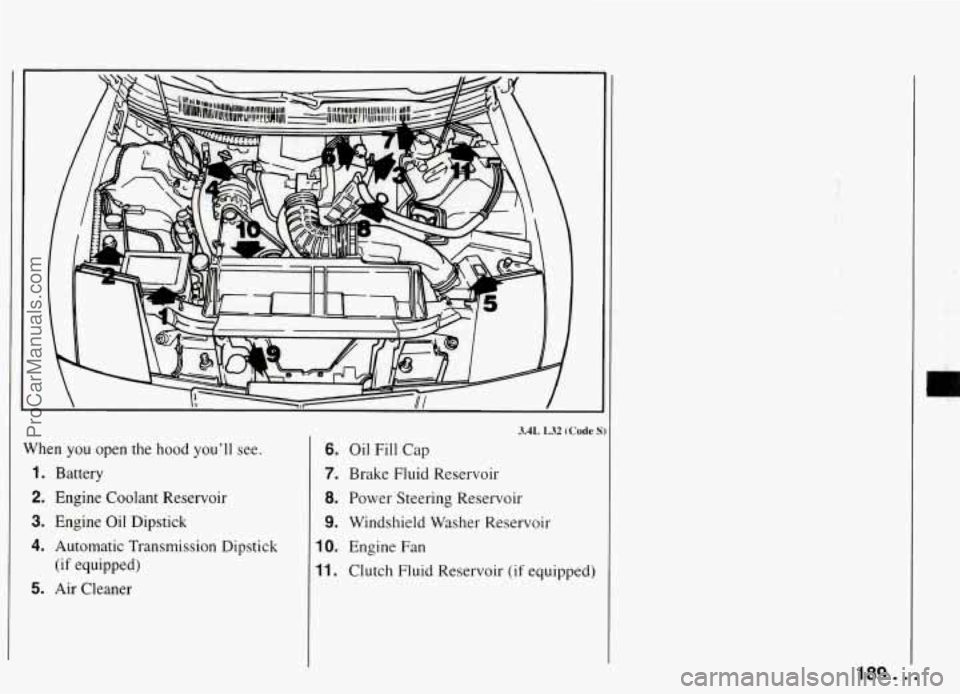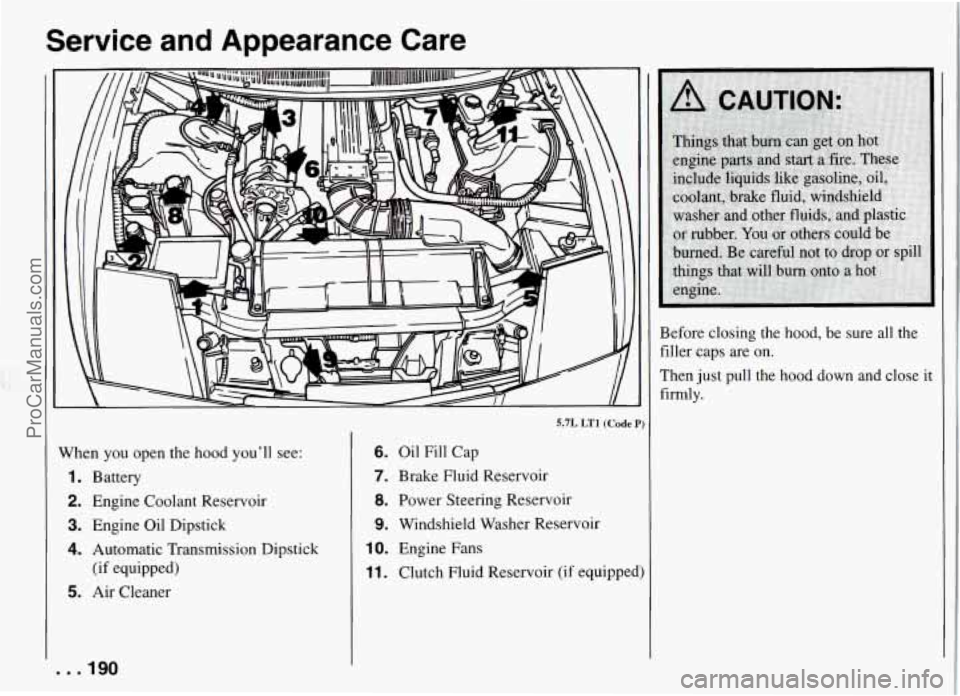automatic transmission PONTIAC FIREBIRD 1994 User Guide
[x] Cancel search | Manufacturer: PONTIAC, Model Year: 1994, Model line: FIREBIRD, Model: PONTIAC FIREBIRD 1994Pages: 290, PDF Size: 14.84 MB
Page 86 of 290

c
w Sun Visors
To block out glare, you can swing down
the visors. You can also swing them to
the side. The elastic bands on your visor
provide extra strorage for maps or papers.
Covered Visor Vanity Mirror
Pull down the sun visor and lift the cover
to expose the vanity mirror.
Ashtray and Lighter
Front Ashtray
Lift up the cover to open the ashtray.
To remove it, lift up on either side of
the ashtray. If you have an automatic
transmission, the ashtray is near the front
of your console. If you have a manual
transmission, the ashtray is near your
cupholder.
NOTICE:
Don’t put papers and other things
that burn into your ashtray. If you do,
cigarettes or other smoking materials
could set them on fire, causing
damage.
Cigarette Lighter
To use the lighter, push it in all the way
and let go. When it’s ready, it will pop
back by itself.
NOTICE:
Don’t hold a cigarette 1ighter:in with
your hand while it is heating. If you
do,
it won’t be able to back away
from the heating element when it’s
ready. That can make it overheat,
damaging the lighter and the heating
element.
If you plug accessories into your cigarette
lighter, such as heating devices or air corn.
pressors, these accessories should have a
rated current of less than
15 amps. Exceed
ing this limit will result in a blown fuse.
85.
’-- ;P ’ 3
ProCarManuals.com
Page 88 of 290

Instrument Panel
1. Fog Lamp Switch (if equipped)
2. Main Light Control
3. Side Upper Air Vent
4. Instrument Cluster
5. Horn
6. Center Upper Air Vent
7. Audio System
8. Glove Box
9. Comfort Controls
10. Cigarette Lighter
11. Parking Brake Lever
12. Cupholder
13. Storage Console and Cassette Tape/
14. Transmission Mode Switch Compact
Disc Storage (as equipped)
(Automatic Transmission)
15. Shift Lever
16. Ashtray (Automatic Transmission)
17. Rear Window Defogger Switch
18. Steering Wheel Controls
19. Remote Hatch Release
20. Convertible Top Switch
21. Traction Control Switch
(if
equipped)
(if equipped)
22. Ashtray (Manual Transmission)
87 ...
ProCarManuals.com
Page 99 of 290

Features and Controls
1. Park on a level surface. Set the
parking brake firmly, shift an
automatic transmission into
“P’ (Park:
or a manual transmission into
“R’
(Reverse). The ignition must be in the
“Acc” or “Run” position. Lower both
sun visors.
NOTICE:
Don‘t lower the top if it is damp or
wet. When the top is down, trapped
water can cause stains, mildew and
damage to the inside of your vehicle.
Be sure to dry
off the top before you
lower it.
NOTICE:
It is not recommended to lower the
top
if your vehicle is out in cold
weather,
0°F (-18°C) or lower.
... 98
)
I
..
I= 2.
NOTICE:
Before lowering the convertible top
into the storage qrea, be sure there
are no objects in
the way of the
folded, stored top. The weight
of a
stored top on items in the storage
area
will cause the convertible top
back glass to break.
Unlock the front of the convertible to;
by pushing on the smaller part of the
latch, then pulling down
on the larger
part
of the latch. Be sure the hook on
the latch that attaches into the hole at
the windshield releases.
-3
I
I
n
tl
p i~
-
fl
1. Be sure no one or nothing is on or
around the top. Push and hold the
bottom of the convertible top switch.
The switch is
on the left side of your
console. The top will automatically lower into the storage area.
nstalling the Boot Cover
ifter lowering the convertible top, you
nay want to install the boot cover. The
hree-piece boot cover
is stored in a bag
n the trunk.
ProCarManuals.com
Page 100 of 290

1.
2. Open the
trunk and remove the
two
side covers from the storage bag.
Install the two side covers by
engaging the tab into the front seatbelt
cover. Lower the covers onto vehicle. 3. Install middle section of cover by
sliding tabs into slots on right side
cover. Lower cover and engage latch.
4. Close the trunk.
To Raise Your Convertible Tap
1. Park on a level surface. Set the
parking brake firmly. If you have an
automatic transmission, shift into
“P”
(Park). If you have a manual
transmission, shift into
“R7 (Reverse).
The ignition must be in the “ACC”
or “Run” position. Lower both sun
visors. Lower both windows at least
three inches. If the boot cover is
in
place, it must be removed first.
2. Open the trunk. Remove the middle
piece
of the cover by pushing in on
the latch and lifting up on the cover.
1
99 ...
ProCarManuals.com
Page 149 of 290

Your Driving and the Road
Backing Up
Hold the bottom of the steering wheel
with one hand. Then, to move the trailer
to the left, just move that hand to the left.
To move the trailer to the right, move
your hand to the right. Always back up
slowly and, if possible, have someone
guide you.
Making 7hms
When you’re turning with a trailer, make
wider turns than normal.
Do this so your
trailer won’t strike soft shoulders, curbs,
road signs, trees, or other objects. Avoid
jerky or sudden maneuvers. Signal well in
advance.
Thrn Signals When Towing a Trailer
When you tow a trailer, your vehicle has
to have a different turn signal flasher and
extra wiring. The green arrows on your
instrument panel will flash whenever you signal a turn or lane change. Properly
hooked up, the trailer lights will also
flash, telling other drivers you’re about to
turn, change lanes or stop. When
towing a trailer, the green arrows
on your instrument panel will flash for
turns even
if the bulbs on the trailer are
burned out. Thus, you may think drivers
behind you are seeing your signal when
they are not. It’s important to check
occasionally to be sure the trailer bulbs
are still working.
Driving on Grades
Reduce speed and shift to a lower gear
before you start down a long or steep
downgrade. If you don’t shift down, you
might have to use your brakes
so much
that they would get hot and no longer
work well.
On a long uphill grade, shift down and
reduce your speed to around
45 mph
(70 km/h) to reduce the possibility of
engine and transmission overheating.
If you are towing a trailer and you
have an automatic transmission with
Overdrive, you may prefer to drive in
“D”
instead of Overdrive (or, as you need to, a
lower gear). Or,
if you have a manual
transmission with fifth (or sixth) gear and
you are towing a trailer, it’s better not to
use fifth (or sixth) gear. Just drive in
fourth gear (fifth gear if you have a six-speed manual transmission) or, as you
need to, a lower gear.
Parking on Hills
You really should not park your vehicle,
with a trailer attached, on a hill. If
-
something goes wrong, your rig could
start to move. People can be injured, and
both your vehicle and the trailer can be
damaged.
But if you ever have to park your rig on a
hill, here’s how to do it:
1. Apply your regular brakes, but don’t
shift into
“P” (Park) yet, or into gear
for a manual transmission.
2. Have someone place chxks under the
3. When the wheel chocks are in place,
release the regular brakes until the
chocks absorb the load. trailer wheels.
4. Reapply the regular brakes. Then
apply your parking brake, and then shift to
“P” (Park), or “R” (Reverse)
for a manual transmission.
5. Release the regular brakes.
. . .I48
ProCarManuals.com
Page 150 of 290

When You Are Ready to Leave after
Parking on a
Hill
1. Apply your regular brakes and hold
the pedal down while you:
0 Start your engine;
0 Shift into a gear; and
0 Release the parking brake.
2. Let up on the brake pedal.
.
3. Drive slowly until the trailer is clear
4. Stop and have someone pick up and
of the chocks.
store the chocks.
Maintenance When Trailer Towing
Your vehicle will need service more often
when you're pulling a trailer. See the
Maintenance Schedule for more on this.
Things that are especially important in
trailer operation are automatic
transmission fluid (don't overfill), engine
oil, axle lubricant, belts, cooling system,
and brake adjustment. Each of these
is
covered in this manual, and the Index will
help you find them quickly. If you're
trailering, it's a good idea to review these
sections before you start your trip.
Check periodically to see that all hitch
nuts and bolts .are tight.
I
I
149.. .
ProCarManuals.com
Page 154 of 290

Jump Starting
If your battery has run down, you may
want to use another vehicle and some
jumper cables to start your Pontiac. But
please follow the steps below to do
it
safely.
11 other. lt tney are, 11 COUIU cause a
NOTICE:
I1
ground connection you don’t want.
You wouldn’t be able to start your
Ignoring these steps could result
in
costlj damage to your vehicle that
wouidn”t be covered by your war-
ranty.
Trying to start your Pontiac by push-
ing or pulling it could damage your
yehicle, even if you have a manual
tran’smission. And if you have
an
automatic transmission, it won’t start
that way.
ro Jump Start Your Pontiac:
1. Cheik the other vehicle. It must have
a 12-volt battery with a negative
If the other system isn’t a 12-volt
system with. a negative ground, both
2. Get the vehicles close enough so the
jumper cables can reach, but be sure
the vehicles aren’t touching each Pontiac, and the
bad grounding could
damage the electrical systems.
3. Turn off the ignition on both vehicles.
Turn
off all lights that aren’t needed,
and radios. This will avoid
sparks and
help save both batteries. And it‘could
save your radio!
I NOTICE:
If you leave your radio on, it could be
badly damaged. The repairs woddn’t
be covered by your warranty.
1
ground system. 4. Open the hoods and locate the
NOTICE: batteries.
153 ...
ProCarManuals.com
Page 184 of 290

I I
Here you will find information
about the care of your Pontiac
.
This part begins with service and fuel information. and then
it
shows how to check important
fluid and lubricant levels
. There
is also technical information
about your vehicle. and a section devoted
to its
appearance care
.
Part b
Service 8t Appearance Care
Service .........................................................
Fuel ...........................................................
Checking Things under the Hood ....................................
HoodRelease ..................................................
184
185
188
188
Engineoil
.................................................... 191
Aircleaner
.................................................... 195
Automatic Transmission Fluid
..................................... 198
Manual Transmission Fluid
....................................... 200
Hydraulic Clutch
............................................... 201
RearAxle
..................................................... 201
Enginecoolant
................................................. 201
Power Steering fluid
............................................ 204
Windshield Washer Fluid
......................................... 205
Brake Master Cylinder
........................................... 206
Bulb Replacement
................................................ 209
Battery
....................................................... 208
LoadingYourVehicle
............................................. 213
Tires
........................................................... 215
Appearance Care
................................................. 221
Appearance Care and Maintenance Materials
.......................... 227
Vehicle Identification Number (VIN)
................................. 228
Service Parts Identification Label
.................................... 228
Add-on Electrical Equipment
....................................... 228
Fuses and Circuit Breakers
......................................... 228
ReplacementBulbs
............................................... 232
Capacities and Specifications
........................................ 233
183 ...
ProCarManuals.com
Page 190 of 290

3.4L L32 (Code !
When you open the hood you'll see.
1. Battery
2. Engine Coolant Reservoir
3. Engine Oil Dipstick
4. Automatic Transmission Dipstick
5. Air Cleaner (if equipped)
6. Oil Fill
Cap
7. Brake Fluid Reservoir
8. Power Steering Reservoir
9. Windshield Washer Reservoir
10. Engine Fan
11. Clutch Fluid Reservoir (if equipped)
B
189 ...
ProCarManuals.com
Page 191 of 290

Service and Appearance Care
5.7L LTl (Code
When you open the hood you'll see:
1. Battery
2. Engine Coolant Reservoir
3. Engine Oil Dipstick
4. Automatic Transmission Dipstick
5. Air Cleaner (if equipped)
6. Oil Fill
Cap
7. Brake Fluid Reservoir
8. Power Steering Reservoir
9. Windshield Washer Reservoir
IO. Engine Fans
11. Clutch Fluid Reservoir (if equippec Before closing the hood,
be sure all the
filler caps are on.
Then just pull the hood down and close it firmly.
-. .190
ProCarManuals.com